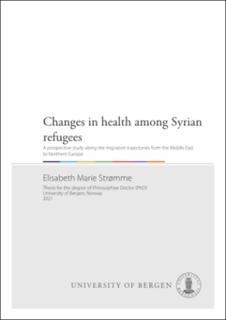Changes in health among Syrian refugees : A prospective study along the migration trajectories from the Middle East to Northern Europe
Doctoral thesis
Permanent lenke
https://hdl.handle.net/11250/2775462Utgivelsesdato
2021-09-24Metadata
Vis full innførselSamlinger
Sammendrag
Background: In the wake of unprecedented numbers of individuals forced to flee due to persecution, conflict, and other human rights violations over the past decade, health implications of forced displacement have become an essential part of the public health agenda for the 21st century. Yet, current knowledge about health among people displaced across borders has important shortcomings. Firstly, the health of displaced individuals in the transit and the early post-migration stage is poorly examined and longitudinal data is scarce. Secondly, the primary focus of research literature on health among people living in displacement has been concentrated around mental health, largely overlooking somatic health aspects.
Objective: The main objective of this PhD project was to describe and analyse the temporal changes in somatic and mental health outcomes and their association with migration related exposures among Syrian refugees transferring from a conflict-near transit phase in the Middle East to an early resettlement phase in Northern Europe.
Methods: This study relies on survey data collected among Syrian refugees in Lebanon and Norway in a combined cross-sectional and longitudinal prospective design. The study is part of the ‘Changing Health and health care needs Along the Syrian Refugees’ Trajectories to Norway’ (CHART) project. Syrian refugees were recruited in connection with mandatory educational activities 1) in the transit phase in Lebanon among individuals selected for quota resettlement to Norway (population A) and 2) in the early resettlement phase in Norway (population B). Participants in Lebanon (population A) were followed prospectively and re-surveyed approximately one year after they had been resettled in 134 different municipalities throughout Norway. Primary outcomes were self-assessed somatic health status (including non-communicable diseases, chronic impairment, and chronic pain), mental health (including symptoms of anxiety, depression, and post-traumatic stress disorder (PTSD)) and use of medication. We investigated the prevalence proportions of main outcomes and their cross-sectional associations with migration related exposures (paper I). Further, we assessed change in prevalence proportions between baseline and follow-up and effect modifiers of change over time (paper II). Lastly, we examined temporal changes in associations between pain, mental health, and migration related exposures (paper III).
Results: In total, 506 Syrians were recruited in Lebanon (population A) and 321 in Norway (population B). Among responders recruited in Lebanon and confirmed resettled in Norway 353 out of 464 (76%) participated in the follow-up. Both in Lebanon and Norway headache was the most prevalent health problem reported, followed by musculoskeletal complaints. Of those with chronic conditions few used relevant medication on a regular basis. Migrating without family members and exposure to refugee related traumatic events were associated with symptoms of anxiety/depression and PTSD, and the latter also with chronic pain (paper I). We found low levels of non-communicable disease at both timepoints (12% to 9%). Somatic complaints such as chronic pain and chronic impairments remained nearly unchanged between the two timepoints (29% to 28% and 30% to 28%, respectively), while mental health outcomes were found to ameliorate, with rates of anxiety/depression dropping from 33% to 11% and PTSD from 5% to 2%. Factors predicting increased improvement in mental health from baseline to follow-up included young age, few years of stay and non-legal status in transit settings (paper II). Reporting symptoms of anxiety/depression at baseline was a statistically significant predictor of chronic pain at follow-up. Most refugees recovered from mental health problems from the transit to the early resettlement phase, but a small group displayed persisting health problems in which chronic pain and mental health problems were interrelated and associated with a range of post-migration stressors. At both timepoints one in four of those with chronic pain used analgesics regularly, whereas none with mental health problems used antidepressants (paper III).
Conclusion: While this thesis affirms mental health problems as an important health concern among refugees, chronic pain is lifted forward as a common challenge with relevance both for wellbeing and integration. The improvement in mental health over our one-year observation period echoes the postulated honeymoon effect in the initial phase after resettlement. Further, this thesis confirms the inherent health risk of trauma experiences, yet highlight that post-migratory exposures, like experiences of poor economy, social relations, and access to relevant information, deserve more attention as important determinants of health among refugees. Receiving countries should intensity efforts to alleviate the burden of post-migratory stressors. Health system responses towards forcibly displaced populations should prevent discontinuity of care for chronic conditions and acknowledge the interrelations between chronic pain and mental health. Therapy interventions towards pain may be a promising way to approach co-morbid mental health disorders. Timing of general health assessments of newly resettled refugees should be tailored to capture both initial needs for continuity of care as well as health problems that may emerge with length of stay. Future research should elongate observation time and evaluate possible interventions both within health promotion, disease prevention and treatment of common conditions among persons displaced across borders.
Består av
Paper 1: Strømme EM, Haj-Younes J, Hasha W, Fadnes LT, Kumar B, Igland J, Diaz E: Health status and use of medication and their association with migration related exposures among Syrian refugees in Lebanon and Norway: a crosssectional study. BMC Public Health 2020, 20(1):341-341. The article is available at: https://hdl.handle.net/11250/2740152Paper 2: Strømme EM, Haj-Younes J, Hasha W, Fadnes LT, Kumar B, Igland J, Diaz E: Changes in health among Syrian refugees along their migration trajectories from Lebanon to Norway: a prospective cohort study. Public Health 2020, 186:240-245. The article is available at: https://hdl.handle.net/11250/2740154
Paper 3: Strømme EM, Igland J, Haj-Younes J, Kumar B, Fadnes LT, Hasha W, Diaz E: Chronic pain and mental health problems among Syrian refugees – associations, predictors, and use of medication over time: a prospective cohort study. BMJ Open. 2021, 11:e046454. The article is available at: https://hdl.handle.net/11250/2783874

